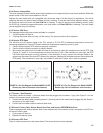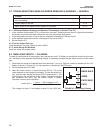
MODEL FCL-1056 SECTION 9.0
TROUBLESHOOTING
9.7.1 Difference Between Analyzer and Standard Thermometer is Greater Than 3°C.
1. Is the standard thermometer, RTD, or thermistor accurate? General purpose liquid-in-glass thermometers,
particularly ones that have been mistreated, can have surprisingly large errors.
2. Is the temperature element in the pH sensor completely submerged in the test liquid?
3. Is the standard temperature sensor submerged to the correct level?
4. Review Section 6.2.
9.7.2 Current Output Too Low.
Load resistance is too high. Maximum load is 550 Ω.
9.7.3 Alarm Relays Do Not Work
Verify the relays are properly wired.
9.8 SIMULATING INPUTS — CHLORINE
To check the performance of the analyzer, use a decade box and 1.5V battery to simulate the current from the sen-
sor. The battery, which opposes the polarizing voltage, is necessary to ensure that the sensor current has the correct
sign.
1. Disconnect the anode and cathode leads from terminals 1 and 2 on TB3 and connect a decade box and 1.5V
battery as shown in Figure 9-3. It is not necessary to disconnect the RTD leads.
2. Set the decade box to 2.8 MΩ.
3. Note the sensor current. It should be about 500 nA. The actual
value depends on the voltage of the battery. To view the sensor cur-
rent, go to the main display and press DIAG. Choose sensor 1. The
input current is the second line in the display. Change the decade
box resistance and verify that the correct current is shown.
Calculate current from the equation:
current (nA) =
The voltage of a fresh 1.5 volt battery is about 1.6 volt (1600 mV).
70
V
battery
— 200 (voltages in mV)
resistance (MΩ)
FIGURE 9-3. Simulating Chlorine
Problem
See Section
New temperature during calibration more than 2-3C° different
from live reading
9.7.1
Current output is too low
9.7.2
Alarm relays do not operate when setpoint is exceeded
9.7.3
9.7 TROUBLESHOOTING WHEN NO ERROR MESSAGE IS SHOWING — GENERAL
7
ANOD SHLD
CATH SHLD
CATH
ANOD
8
9
10
R


















